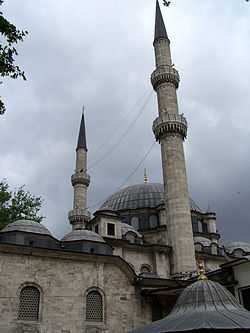Eyüp Sultan Mosque
| Eyüp Sultan Mosque | |
|---|---|

Eyüp Sultan Mosque | |
| Basic information | |
| Location | Istanbul, Turkey |
| Geographic coordinates | 41°02′52.61″N 28°56′01.63″E / 41.0479472°N 28.9337861°E |
| Affiliation | Islam |
| Architectural description | |
| Architectural type | Mosque |
| Architectural style | Ottoman architecture |
| Completed | 1458 |
| Specifications | |
| Minaret(s) | 2 |
The Eyüp Sultan Mosque (Turkish: Eyüp Sultan Camii) is situated in the district of Eyüp on the European side of Istanbul, near the Golden Horn, outside the Walls of Constantinople. Built in 1458, it was the first mosque constructed by the Ottoman Turks following the Conquest of Constantinople in 1453.[1]
The mosque rises next to the place where Abu Ayyub al-Ansari (Turkish: Eyüp Sultan), the standard-bearer of the Islamic prophet Muhammad, is said to have been buried during the Arab assault on Constantinople in 670. His tomb is greatly venerated by Muslims, attracting many pilgrims. Some of the personal belongings of Muhammad are preserved in the building that houses the tomb.
On 31 August 1876, Abdul Hamid II rode to the Eyüp Sultan Mosque. There, he was given the Sword of Osman whereby he ascended the throne.[2]
Gallery
|
See also
References
- ↑
- ↑ Hoiberg, Dale H., ed. (2010). "Abdulhamid II". Encyclopedia Britannica. I: A-ak Bayes (15th ed.). Chicago, IL: Encyclopedia Britannica Inc. p. 22. ISBN 978-1-59339-837-8.
- Mehmet Nami Haskan, Eyüpsultan Tarihi, Eyüpsultan Vakfı Yayınları, Istanbul 1996.
External links
![]() Media related to Eyüp Sultan Mosque at Wikimedia Commons
Media related to Eyüp Sultan Mosque at Wikimedia Commons
| Wikimedia Commons has media related to Eyüp Sultan Mosque. |
Coordinates: 41°02′52.61″N 28°56′01.63″E / 41.0479472°N 28.9337861°E









